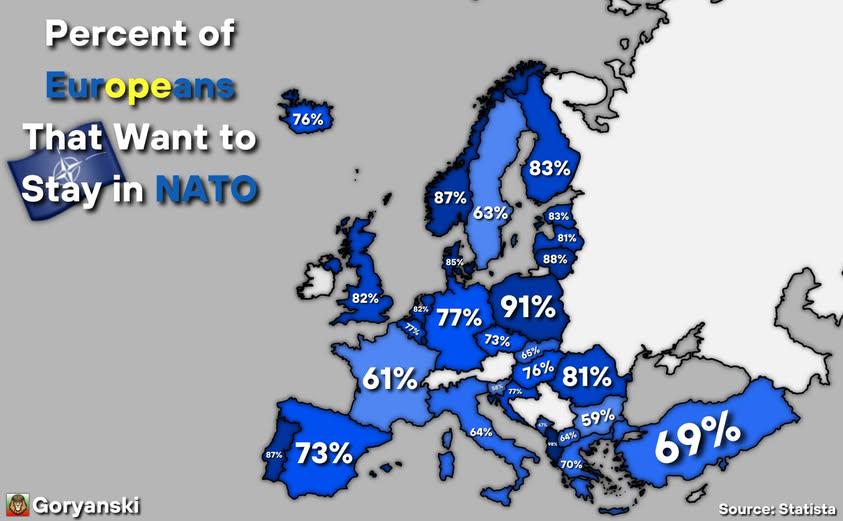NATO Support in Europe 2024 Map


Alex Cartwright
Senior Cartographer & GIS Specialist
Alex Cartwright is a renowned cartographer and geographic information systems specialist with over 15 years of experience in spatial analysis and data...
Geographic Analysis
What This Map Shows
The "Percent of Europeans That Want to Stay in NATO In 2024" map provides a visual representation of public sentiment across European nations regarding their continued membership in the North Atlantic Treaty Organization (NATO). This visualization highlights how various countries feel about NATO's role in ensuring security and stability in the region. As we delve deeper into this topic, it's essential to understand not just the numbers but the geopolitical context and historical factors influencing these sentiments.
Deep Dive into NATO Membership and Public Opinion
NATO, established in 1949, was primarily a collective defense mechanism against the threats posed by the Soviet Union. Over the decades, its mission has evolved, encompassing various aspects of international security, including crisis management and cooperative security. As we approach 2024, public opinion on NATO varies significantly among European nations, reflecting a complex interplay of historical relationships, security concerns, and the shifting geopolitical landscape.
Interestingly, support for NATO membership is often correlated with perceptions of security threats. For instance, countries that have faced recent aggression or security dilemmas, such as the Baltic states—Estonia, Latvia, and Lithuania—show high levels of support for NATO. This is not surprising, given their geographical proximity to Russia and the historical context of past invasions. As of 2024, these nations report over 80% of citizens wanting to remain in NATO, viewing it as a crucial deterrent against potential threats.
On the other hand, nations with more stable security environments, such as Portugal or Spain, exhibit more moderate levels of support. In these countries, opinions hover around the 60% mark, reflecting a different perspective on NATO's relevance to their national security. This variance raises an interesting question: What shapes public opinion on such a significant international alliance?
The media plays a vital role in shaping perceptions. In countries where NATO's actions are prominently featured in news cycles—whether through joint military exercises or responses to international crises—public awareness and support tend to be higher. Conversely, in nations where NATO's presence is less pronounced, the connection feels more abstract, leading to lukewarm support.
Furthermore, the rise of populism and nationalism across Europe has also influenced attitudes toward NATO. Some political factions argue for a reevaluation of international alliances, advocating for a more isolationist approach. This sentiment can complicate public opinion and create divisions within countries regarding NATO's future.
Regional Analysis
When examining the map, we can break down the NATO sentiment by regions. In Northern Europe, particularly among the Nordic countries, there is a notable trend of strong support for NATO. Sweden and Finland, countries historically skeptical about NATO membership, have seen increasing public backing, especially in light of heightened tensions with Russia. The 2024 figures reflect a shift, with both countries reporting around 70% support, indicating a significant change in public sentiment.
In Western Europe, the sentiment is more mixed. Countries like France and Germany have historically held more ambivalent views towards NATO, often advocating for a more autonomous European defense strategy. However, recent geopolitical events have reignited discussions about the necessity of collective defense, leading to a rise in support, with Germany reporting about 65% favorability in 2024.
Conversely, in Southern Europe, we see a fascinating pattern. Countries like Italy and Greece have varying levels of support, with Italy reporting around 58% and Greece at a surprising 73%. This disparity underscores the unique historical and geopolitical context of each nation, including Greece's regional tensions and Italy's strategic positioning within the Mediterranean.
Significance and Impact
Understanding the levels of support for NATO across Europe in 2024 is crucial for several reasons. Firstly, it highlights the evolving security landscape in Europe, where historical alliances are being reassessed against contemporary threats. As countries weigh their security needs against the backdrop of global instability, the declining or rising support for NATO could significantly impact future defense policies and international relations.
Moreover, the implications extend beyond military alliances. Countries that favor NATO membership tend to support increased defense budgets and collaborative military strategies, which can lead to stronger ties within the alliance. In contrast, nations leaning towards withdrawal may push for alternative security arrangements, potentially destabilizing the current balance of power in Europe.
As we look to the future, projections indicate that NATO's relevance will remain a key topic of discussion in European politics. The ongoing war in Ukraine, for instance, has already influenced public opinion in favor of NATO in various countries. However, as global dynamics shift, will this support hold, or will we see a reemergence of skepticism?
In conclusion, the "Percent of Europeans That Want to Stay in NATO In 2024" map offers a glimpse into a pivotal moment for European security. As public opinion shapes the future of NATO, it will be fascinating to watch how these trends evolve in the coming years and what that means for Europe’s collective defense strategy.
Visualization Details
- Published
- August 9, 2025
- Views
- 158
Comments
Loading comments...